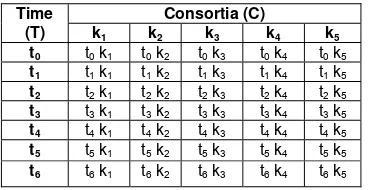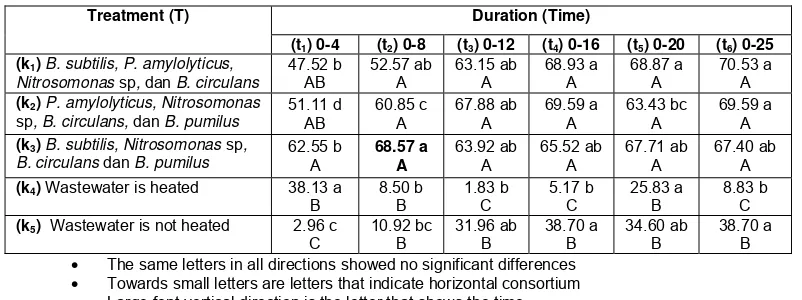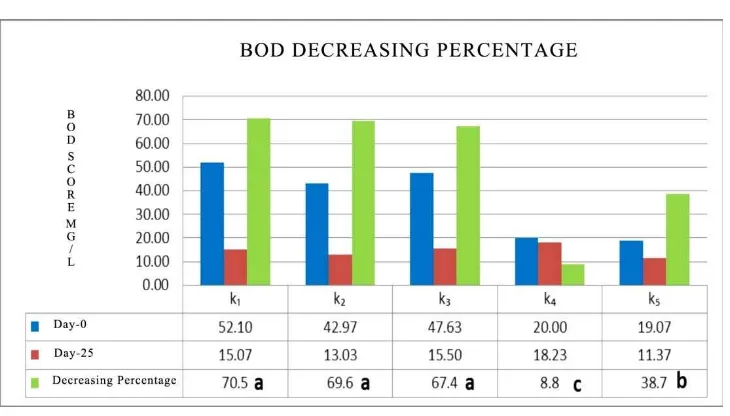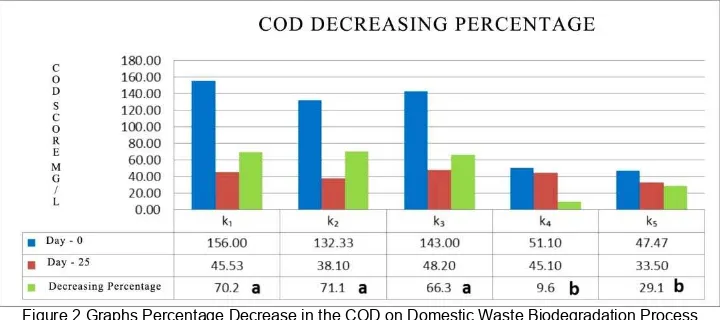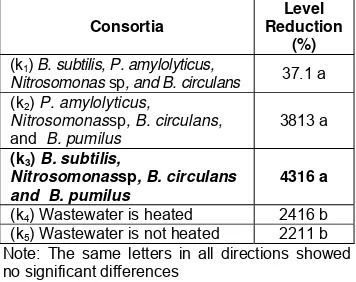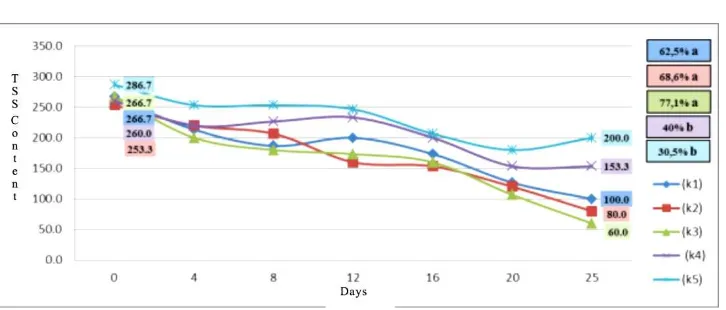DOMESTIC WASTE WATER BIOREMEDIATION
BY CONSORTIUM OF BACTERIA
Ratu Safitri
1*, Bambang Priadie
2, Anindhita Hawadish
11
Padjadjaran University, Indonesia 2
Station for water Environment, Research and Development Institut for Water Resources, Department of Public Works, Indonesia
Abstract
Research has been carried out to obtain an effective bacterial consortium in the biodegradation of domestic wastewater WWTP Bojongsoang. The method used in this study is an experimental method to completely randomized design (CRD) consisting of 2 factors and repeated 3 times. The first factor is the type of bacterial consortia, these were (k1) Consortium of Bacillus subtilis, Paenibacillus amylolyticus, Nitrosomonas, and Bacillus circulans, (k2) Consortium of Paenibacillus amylolyticus, Bacillus Nitrosomonas circulans, and Bacillus pumilus; (k3) Consortium of Bacillus subtilis, Nitrosomonas, Bacillus circulans and Bacillus pumilus; (k4) of domestic wastewater was heated; (k5) of domestic wastewater was not heated. The second factor is the time of bioremediation (T) of consisting of 8 levels, namely (t0) initial day, (t1) day 4, (t2) day 8, (t3) Day 12, (t4) Day 16 (t5) Day 20, (t6) Day 25. The results showed that the bioremediation by the consortium of Bacillus subtilis, Nitrosomonas, Bacillus circulans and Bacillus pumilus (k3) are effective in lowering the levels of domestic wastewater BOD 67.4 % of BOD, COD 66.3 %, and 77.1% TSS.
Key words: Bioremediation, Domestic waste water, BOD, COD, TSS
INTRODUCTION1
Water pollution found in rivers in the cities is the result of domestic waste disposal. Domestic wastewater contains high organic matter. Organic matter in the wastewater is composed of 65% protein, 25% carbohydrate and 10% fat, while the inorganic material is salt and metal (15). There is also ammonia from urine and feces produced by human waste. Efforts to control water pollution due to domestic waste needs to be done in order not to degrade the quality of water.
In Indonesia, especially in West Java have been there several installations Wastewater Treatment Plant (WWTP) to treat domestic waste such as wastewater Bojongsoang. Waste Water Treatment Plant (WWTP) located in Bojongsoang is household waste water treatment plant that contains a lot of organic material distributed through the channels. Installation is to process effluent from the domestic household area of Bandung and
*Corresponding author: ratusafitrie@yahoo.com
Bandung East South Central with a service capacity of 400,000 inhabitants. WWTP was constructed to reduce the level of water pollution that enters Citarum River by biological treatment system with stabilization ponds (Siregar, 2004). Biological treatment of domestic sewage in wastewater Bojongsoang require 14 stabilization ponds consisting of two sets is the set A and set B. Before entering into the waste stabilization ponds, domestic wastewater collected in the pond inlet that has a level of BOD 91 mg/l, COD 159 mg/l, DO of 3.15 mg/l pH 6, and TSS concentration of 200 mg.
Biodegradation of domestic wastewater using a consortium of bacteria indigenous and non-indigenous is a biological wastewater treatment method that effectively and efficiently. Bacteria that are used must have the ability to decompose organic matter, such as being able to degrade cellulose, lipids, and proteins. An indigenous microbe normally present in domestic waste is the genus Bacillus, Aerobacter, Nitrobacter,
bacteria commonly cellulolytic, proteolytic, and lipolytic, aerobic or facultative anaerobic. Nitrosomonas is able to reduce ammonia. The genus Bacillus is widely used in wastewater treatment population (4)
While Nitrosomonas convert ammonia to nitrite, and Nitrobacteria convert nitrite to nitrate this is harmless and required by plants.
In this study, a consortium of B. subtilis, B. circulans, B. pumilus and Paenibacillus amylolyticus of indigenous domestic sewage WWTP Bojongsoang used for domestic waste biodegradation Bojongsoang WWTP. The use of bacterial consortium is expected to reduce levels of Biological Oxygen Demand (BOD), Chemical Oxygen Demand (COD) and (TSS) of domestic wastewater. The purpose of this study was to determine the ability of some strains of bacteria indigenous consortium WWTP Bojongsoang for biodegradation of domestic wastewater.
METHODS
This research method using experimental methods with completely randomized design (CRD) consisting of 2 factors and 3 replication. The first factor is the type of bacterial consortium (K) and the second factor is time (T). The number of replications is determined by the formula Federer, the (n-1) (t-1) ≥ 30, with n = number of treatments; t = number of replicates, to obtain the number of repetitions (t) three times, earned total of 40 experimental trials as presented in Table 1.
Table 1 Treatment Combination Table
Time (T)
Consortia (C)
k1 k2 k3 k4 k5
t0 t0 k1 t0 k2 t0 k3 t0 k4 t0 k5 t1 t1 k1 t1 k2 t1 k3 t1 k4 t1 k5 t2 t2 k1 t2 k2 t2 k3 t2 k4 t2 k5 t3 t3 k1 t3 k2 t3 k3 t3 k4 t3 k5 t4 t4 k1 t4 k2 t4 k3 t4 k4 t4 k5 t5 t5 k1 t5 k2 t5 k3 t5 k4 t5 k5 t6 t6 k1 t6 k2 t6 k3 t6 k4 t6 k5
Data obtained were statistically tested using analysis of variance test (ANOVA) to determine the effect of treatment of the parameters tested, followed by Duncan test. This study was conducted to obtain the type of bacterial consortium and the optimal time for the lower levels of BOD and COD in wastewater biodegradation of domestic wastewater Bojongsoang with the following steps:
a) Biochemical Oxygen Demand (BOD)
The method is based on reference SNI M-69-1990-03 (1990)
b) Chemical Oxygen Demand (COD)
The method is based on the reference APHA (2),
c) Total Suspended Solid (TSS)
ISO reference method based on 06-6989.3-(2004)
RESULTS AND DISCUSSIONS
Levels of BOD (Biochemical Oxygen Demand) During Domestic Wastewater Biodegradation Process
Table 2 Interaction Consortium Test against Bacteria and Time Percentage Decreased Levels of BOD (%) Domestic Wastewater
Treatment (T) Duration (Time)
(t1) 0-4 (t2) 0-8 (t3) 0-12 (t4) 0-16 (t5) 0-20 (t6) 0-25
(k1) B. subtilis, P. amylolyticus,
Nitrosomonas sp, dan B. circulans
47.52 b
(k2) P. amylolyticus, Nitrosomonas sp, B. circulans, dan B. pumilus
B. circulans dan B. pumilus
62.55 b • The same letters in all directions showed no significant differences
• Towards small letters are letters that indicate horizontal consortium Large font vertical direction is the letter that shows the time
In Table 2 it can be seen that the process of biodegradation of organic matter in the Wastewater from day 8 to the liver to 25. Consortium Bacillus subtilis, Nitrosomonas, Bacillus circulans and Bacillus pumilus (k3) can reduce levels of domestic wastewater BOD highest at 68, 57%. Decreased of BOD levels also take place during the process of biodegradation in the wastewater produced by a consortium of bacteria Bacillus subtilis, Paenibacillus amylolyticus, Nitrosomonas,
and Bacillus circulans (k1). Biodegradation of organic materials for 8 days has reduced more than 50% BOD levels. Decreased levels of rapid BOD indicate the presence of synergy interactions in the consortium. According to Valbuzzi (17) B. subtilis is a bacterium that can be found in soil, water, air, and plants, contribute to nutrient cycling because it produces a variety of enzymes. Furthermore, many members of Bacillus produce extra - and intracellular proteases celllular and has been used intensively to produce amylase and protease on an industrial scale (7). Several Bacillus species are also known to be produced commercially for use as a fertilizer and soil nitrifier nitrification in aquaculture systems due to a breakdown of protein and organic matter into ammonia and subsequent nitrification process. Biodegradation process only reached 70 percent during the 25 days, it is thought to be caused reduced the amount of organic
metabolism that can be toxic and inhibit microbial growth rate and decrease the rate of reduction of BOD
Here is a chart to decreased levels of BOD results biodegradation of domestic wastewater (fig. 1). In Figure 1. Known that bacterial consortium Bacillus subtilis, Paenibacillus
amylolyticus, Nitrosomonas, and Bacillus
circulans (k1) resulted in a decrease in the BOD levels high at 70.5%, but did not differ with the resulting decrease in bacterial consortium Paenibacillus amylolyticus, Nitrosomonas, B. circulans, and B. pumilus.
(k2) and a consortium of B. subtilis Nitrosomonas, B. circulans and B. Pumilus
Figure 1 Percentage Decrease Levels Charts of BOD (%) During the process of Biodegradation of Domestic Waste Water Description:
k1: Bacillus subtilis, Paenibacillus amylolyticus, Nitrosomonas, and Bacillus circulans
k2: Paenibacillus amylolyticus, Nitrosomonas, Bacillus circulans, and Bacillus pumilus. k3: Bacillus subtilis, Nitrosomonas, Bacillus circulans and Bacillus pumilus.
k4: domestic wastewater sterile
k5: domestic wastewater that is not in the sterile
Therefore decompose organic material in domestic sewage, Nitrosomonas sp using oxygen resulting in decreased levels of BOD. The survey results revealed that the average BOD levels were obtained at 15.1 mg/l BOD includes quality standards of domestic wastewater is 100 mg/l. Thus the decrease in BOD levels in the addition of bacterial consortium showed that the bacteria used plays a role in lowering levels of BOD. The study found that the average BOD levels were obtained at 15.1 mg/l BOD includes quality standards of domestic wastewater is 100 mg/l. Thus the decrease in BOD levels in the addition of bacterial consortium showed that the bacteria used plays a role in lowering level of BOD.
Levels of COD (Chemical Oxygen Demand) During Domestic Wastewater Biodegradation Process
Chemical Oxygen Demand is the amount of oxygen needed to decompose the entire
Table 3 Test Interaction Consortium Against Bacteria and Time Percentage Decrease Levels of COD (%) Domestic Liquid Waste
Treatment (K)
Time (T)
(t1) 0-4 (t2) 0-8 (t3) 0-12 (t4) 0-16 (t5) 0-20 (t6) 0-25
(k1) B. subtilis, P. amylolyticus,
Nitrosomonas sp, danB. circulans
5.66 c
(k2) P. amylolyticus, Nitrosomonas sp, B. circulans, dan B. pumilus
B. circulans dan B. pumilus
34.01 d Note: Different letters indicate there is a very real difference
The same letters in all directions showed no significant differences Towards small letters are letters that indicate horizontal consortium Large font vertical direction is the letter that shows the time
In Table 3 known that within 12 days the consortium of Paenibacillus amylolyticus, Nitrosomonas, Bacillus circulans, and Bacillus
pumilus (k2) the best in lowering domestic
wastewater COD is equal to 65.07%, and this continued until the day 25. The result of the reduction in COD levels did not differ with decreased levels of COD by a consortium of
Bacillus subtilis, Paenibacillus amylolyticus, Nitrosomonas, and Bacillus circulans (k1) and a consortium of Bacillus subtilis, Nitrosomonas, Bacillus circulans and Bacillus pumilus (k3). But the consortium k3 slower than the other two consortia. However, it can be said that the reduction in COD levels within 12 days already provide more than 50% decline. Decreased levels of COD quickly showed the presence of
synergism between species member in the consortium. According Roheim (13), and B. subtilis B.circulans, B.pumilus belong to the genus Bacillus are capable to decompose cellulose, but it is also the genus Bacillus lipid compounds break down into glycerol and fatty acids to be used as a source of nutrients. On the other hand, Nitrosomonas sp. is also able to transform the ammonia into nitrite.
Paenibacillus amylolyticus also produce the enzyme cellulase. Thus it can be said that the more organic materials are broken down by bacteria, the greater the amount of COD reduction in wastewater. Here is a chart to decreased levels of COD results biodegradation of domestic wastewater.
Figure 2 Graphs Percentage Decrease in the COD on Domestic Waste Biodegradation Process Description: k1: Bacillus subtilis, Paenibacillus amylolyticus, Nitrosomonas, and Bacillus circulans
k2: Paenibacillus amylolyticus, Nitrosomonas, Bacillus circulans, and Bacillus Pumilus
Based on Figure 2. Known consortium of
Paenibacillus amylolyticus, Nitrosomonas, Bacillus circulans, and Bacillus pumilus (k2) resulted in a decrease in the COD levels high at 71.1 %. The reduction in COD levels are not different from the reduction in COD levels produced by consortium of Bacillus subtilis, Paenibacillus amylolyticus,
Nitrosomonas, and Bacillus circulans (k1)
and a consortium of Bacillus subtilis,
Nitrosomonas, Bacillus circulans and
Bacillus pumilus (k3). This suggests that the members of the consortium are synergistic in lowering the COD levels higher than the control and the bacterial consortium third as effective in lowering domestic wastewater COD. Decreased levels of COD occur because the bacteria are able to consume organic matter as a nutrient substrate. This is consistent with the statement Fardiaz, (6) in Thamrin (16) microorganisms in sewage continuously throughout the metabolic process energy needs are met and will produce compounds that can have an impact on the decline in the value of COD.
Levels of Total Suspended Solid (TSS) during the process of Biodegradation of Domestic Waste Water
Total Suspended Solid (TSS) or solids suspension is a set of solids consisting of particles smaller size and weight compared to the sediment, such as organic matter and microorganisms cells (10). Suspended solids in the water are polluting the environment because it is not soluble and are not directly deposited in waters that can cause water turbidity. Suspension solids levels can be reduced by microorganisms that help decompose organic compounds work becomes simpler. Based on the results of ANOVA is known that there is no interaction between bacterial consortium and TSS levels at the time of the domestic wastewater, but the consortium of bacteria and time effect on TSS levels decrease during biodegradation process in domestic wastewater. Based on these results we performed Duncan’s Multiple Range Test as an advanced test.
Table 4 Effect of Duncan's Multiple Range Test Consortium Against Decrease of Level in TSS (%) Domestic Liquid Water
Consortia
Level Reduction
(%)
(k1) B. subtilis, P. amylolyticus,
Nitrosomonas sp, and B. circulans 37.1 a
(k2) P. amylolyticus,
Nitrosomonassp, B. circulans,
and B. pumilus
3813 a
(k3) B. subtilis,
Nitrosomonassp, B. circulans and B. pumilus
4316 a
(k4) Wastewater is heated 2416 b
(k5) Wastewater is not heated 2211 b
Note: The same letters in all directions showed no significant differences
In Table 4 it is known that a consortium of
Bacillus subtilis, Nitrosomonas, Bacillus circulans and Bacillus pumilus (k3) gave the highest TSS levels decrease to 43.6%. These results did not differ with decreased levels of TSS by a consortium of Paenibacillus amylolyticus, Nitrosomonas, Bacillus circulans,
and Bacillus pumilus (k2), and a consortium of Bacillus subtilis, Paenibacillus amylolyticus, Nitrosomonas, and Bacillus circulans (k1). Thus it can be said that the three consortium equally effective to reduce TSS, which means that the bacteria in the consortium has the ability to decompose organic matter in domestic wastewater suspended substance.
In Table 5 it is known that on the 25th day of use bacterial consortium able to reduce the high levels of TSS, but not different on day 20. Thus it can be said that the highest TSS levels decrease after 20 days. Graph of reduction in TSS levels for domestic wastewater biodegradation process (Figure 3).
Table 5 Duncan's Multiple Range Test Against Time Effect Decreased Levels of TSS (%)
TIME CONTENT DECREASING (%)
(t1) 0-4 16.9 c
(t2) 0-8 20.2 bc
(t3) 0-12 24.7 bc
(t4) 0-16 33.0 b
(t5) 0-20 48.3 a (t6) 0-25 55.7 a
Figure 3 Reduction levels of Total Solid Suspended During Domestic Wastewater Biodegradation Description:
k1: Bacillus subtilis, Paenibacillus amylolyticus, Nitrosomonas, and Bacillus circulans
k2: Paenibacillus amylolyticus, Nitrosomonas, Bacillus circulans, and Bacillus pumilus
k3: Bacillus subtilis, Nitrosomonas, Bacillus circulans and Bacillus pumilus
k4: domestic wastewater heated k5: domestic wastewater is not heated
Based on Figure 3 it can be seen that the consortium of Bacillus circulans, Bacillus pumilus, Bacillus subtilis, and Nitrosomonas
sp (k3) gave the highest TSS levels decrease in the amount of 77.1 %. The ability to reduce levels of TSS did not differ with the ability to decrease the levels of TSS consortium Paenibacillus amylolyticus, Nitrosomonas, Bacillus circulans, and
Bacillus pumilus (k2) and a consortium of
Bacillus subtilis, Nitrosomonas, Bacillus circulans and Bacillus pumilus (k3). This suggests synergistic species in the consortium so as to outline the solute particles in domestic wastewater. These results also indicate that the three types of bacteria consortium is effective in lowering the levels of domestic effluent TSS. B. subtilis and B. circulans high cellulolytic ability, thus containing cellulose dissolved solids will be described. Besides B. subtilis
and B. Circulans, Bacillus genus includes
groups that have the ability to decipher crude fiber and lignin are difficult to decompose lignin and delignification process through hydrolysis of cellulose so solid that dissolved organic matter in the form of lignin, lipids, and cellulose in the waste water can be reduced (18). B. pumilus and Nitrosomonas
sp. also has the ability to remodel organic
bacteria are bacteria found in the waste containing organic material and effectively decompose organic matter in the wastewater. The study revealed that the levels of TSS were obtained as 60 mg/l TSS has entered the standard quality of domestic wastewater is 100 mg/l, with a decrease in TSS levels in the entire addition of bacterial consortium showed that the bacterial consortium used a role in lowering the levels of TSS.
CONCLUSIONS
Based on those result of this study concluded that consortium of Bacillus subtilis, Nitrosomonas, Bacillus pumilus and Bacillus circulans effective in the biodegradation of domestic wastewater for being able to reduce level of BOD 67.4%, COD 66.3%, and TSS 77.1% TSS in the process biodegradation of domestic wastewater.
ACKNOWLEDGEMENTS
We would like to Thank to Research and Development Institut for Water Resources, Department of Public Works, Indonesia that has funded this study.
REFERENCES
daur biogeokimia diakses pada 10 Oktober 2013 pukul 15.00 WIB.
[2] APHA (American Public Health Association) 1995: Standard Methods for The Examination of Water and Wastewater 17th ed. APHA. AWWA.WPCF.Washington D.C. 1527 p.
[3] Boyd, C.E. 1990: Water quality in ponds for aquaculture.Alabama agricultural Experiment Station, Auburn University, Alabama.482 p. [4] Buthelezi, S. P., Olaniran, A. O. and Pillay, B. 2009: Turbidity and microbial load removal from river water using bioflocculants from indigenous bacteria isolated from wastewater in South Africa, African Journal of Biotechnology Vol. 8 (14), pp. 3261-3266, 20 July, 2009. ISSN 1684–5315 © 2009 Academic Journals
[5] Eko, 2013: Bakteri Pengurai Limbah. http://pengurailimbahcair.blogspot.com/2013/02/b akteri-pengurai limbah.html
[6] Fardiaz, S. 1992: Mikrobiologi Pangan. PT. Gramedia. Bandung.
[7] Fleming, A.B., Tangney, M. Jorgensen, P.L., Diderrichsen, B and Priest, F.G. (1995): Extracellular enzymes synthesis in a sporulation deficient strain of Bacillus licheniformis. Applied and Environmental Microbiology. 61(11):3775-3780.
[8] Hairiyah, K dan Handayanto, E. 2007: Biologi Tanah Landasan Pengelolaan Tanah Sehat. Edisi 3. Pustaka Adipura. Jakarta
[9] Lynd L.R., J.W. Paul, W.H. Van Zyl dan S.P. Isak. 2002: Microbial Cellulose Utilization : Fundamentals and Biotechnology. Microbial and Mol Boil Rev. 66(3): 506-507.
[10] Margareth, E. 2009: Analisis Kadar Total Suspended Solid (TSS), Amoniak (NH3), Sianida
(CN) dan Sulfida S-2 Pada Limbah cair Departemen Kimia FMIPA Universitas Sumatera Utara.
[11] Metcalf & Eddy. 1993: Wastewater Engineering Treatment Disposal Reuse. McGraw-Hill Comp.
[12] Rheinheimer 1980: Aquatic Microbiology, A. willey Inter Science Publication Chichester: 225 pp.
[13] Roheim, J. R. 2011: Low Cost Automated On Site System For Growing And Dispending Vegetative Bacteria. http://www. repository.usu.a.id/bitstream/ 123456789/ [14] Siregar, Sohuturon, 2004: Studi Sistem Oprasi dan Pemeliharaan (O&P) Instalasi Pengolahan Air Limbah (IPAL) (Studi Kasus IPAL Bojongsoang Kota Bandung).Tesis. Program Pasca Sarjana. Universitas Dipenogoro. Semarang [15] Sugiharto, 1987: Dasar-dasar Pengelolaan Air Limbah. UI-PRESS, Jakarta.
[16] Thamrin, Jasmiati, Sofia, A. 2010: Bioremediasi Limbah Cair Industri Tahu Menggunakan Efektif Mikroorganisme (Em4). Ilmu Kingkungan. Journal of Environmetal Science.
[17] Valbuzzi, A., Ferrari, E. and Albertini, A. M. (1999): Anovel member of the subtilisin-like protease family from Bacillus subtilis. Microbiology. 145:3121-3127.
